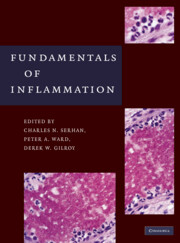Book contents
- Frontmatter
- Contents
- Contributors
- Preface
- PART I THE INFLAMMATORY RESPONSE – AN OVERVIEW
- PART II INDIVIDUAL CELL TYPES
- 4A Neutrophils I
- 4B Neutrophils II
- 5 Mast Cells as Sentinels of Inflammation
- 6 Basophils
- 7 Eosinophils
- 8 Macrophages
- 9 Lymphocytes
- 10 Fibroblasts and Stromal Cells
- 11 Neutrophil–Endothelial Cell Interactions
- PART III CHEMICAL MEDIATORS
- PART IV IMMUNOPHARMACOLOGY
- PART V INFLAMMATORY DISEASES/HISTOLOGY
- PART VI ANIMAL MODELS OF INFLAMMATION
- Index
- References
6 - Basophils
from PART II - INDIVIDUAL CELL TYPES
Published online by Cambridge University Press: 05 April 2014
- Frontmatter
- Contents
- Contributors
- Preface
- PART I THE INFLAMMATORY RESPONSE – AN OVERVIEW
- PART II INDIVIDUAL CELL TYPES
- 4A Neutrophils I
- 4B Neutrophils II
- 5 Mast Cells as Sentinels of Inflammation
- 6 Basophils
- 7 Eosinophils
- 8 Macrophages
- 9 Lymphocytes
- 10 Fibroblasts and Stromal Cells
- 11 Neutrophil–Endothelial Cell Interactions
- PART III CHEMICAL MEDIATORS
- PART IV IMMUNOPHARMACOLOGY
- PART V INFLAMMATORY DISEASES/HISTOLOGY
- PART VI ANIMAL MODELS OF INFLAMMATION
- Index
- References
Summary
INTRODUCTION
Named after their affinity for alkaline stains and possessed of numerous potent inflammatory substances, basophils are the rarest of the granulocytes, typically constituting 0.5%–1.5% of peripheral blood leukocytes. Studied both for their suspected effector roles in parasitic and allergic diseases and for their similarity to mast cells, these peripheral blood cells are increasingly hypothesized to have important immunoregulatory functions. This chapter focuses primarily on the human basophil, but makes reference to the basophils of other species to point out phenotypic differences from human basophils, to describe phenomena that have been elucidated best in nonhuman basophils, and to describe murine and other mammalian models of disease in which the role of the basophil has been explored.
IDENTIFICATION
Historical Discovery
Paul Ehrlich, the German Nobel prize winner who made foundational contributions to immunology, is credited with the first description of the human basophil in 1879 in a paper in which he also proposed the name Mastzellen for connective tissue cells that also took up aniline dyes in their numerous cytoplasmic granules. Because of their infrequency among peripheral blood leukocytes, basophils were given scant attention until their functional similarity to mast cells in terms of IgE-mediated histamine release was appreciated more than eight decades later.
Development
Like other leukocytes, basophils derive from totipotent hematopoietic stem cells, and are believed to arise from the common myeloid precursor by means of the common granulocyte precursor.
- Type
- Chapter
- Information
- Fundamentals of Inflammation , pp. 74 - 85Publisher: Cambridge University PressPrint publication year: 2010



